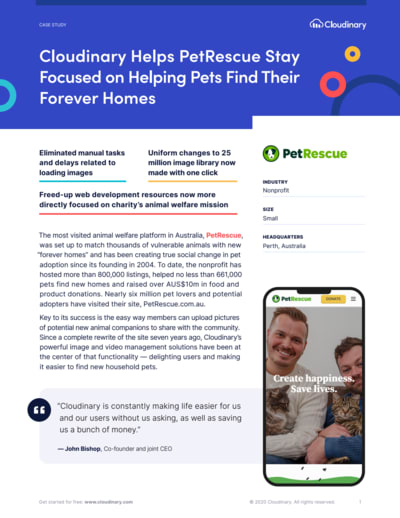As we spend more time at home, many of us are adopting pets for the joy, companionship and a surprising range of health benefits. In Australia, where our nonprofit customer PetRescue is located, there’s a shortage of pets to adopt. Last August, the Guardian reported that dog shelters in Australia emptied and adoption fees for puppies were running as high as $AUS1800.
PetRescue, Australia’s most visited (6 million+ visitors since 2004) animal welfare site has helped 661,000 pets find their forever homes through more than 800,000 listings on its website PetRescue.com.au. PetRescue also challenges legislation and recommends creative solutions to create real social change. As a pet lover myself, I am truly inspired by the work of this tireless organization!
In 2020 alone, more than 300,000 enquiries from potential adopters have hit the website. And with more web traffic, comes a heavy admin burden; especially on a site like PetRescue’s that hosts a staggering 25 million+ images and gains 80,000 new listings every year via user-generated content (UGC), each with up to 30 associated images. This busy charity can ill afford to squander precious time and resources on labor-intensive image management.
Even before COVID, staying current with web functionality and image management proved challenging, as PetRescue’s Co-founder and Joint CEO John Bishop (“JB”) explains: “Over 16 years the website’s been through a number of iterations and was completely torn down and rebuilt in 2011 to ’12,” he states. “But even after all those enhancements, the process of uploading images was difficult for the end user.”
Before Cloudinary, when a user created a listing, their animal photos had to be uploaded to a front-end server then to an Amazon AWS S3 bucket, queued, transformed then sent back to S3 and the image updated. When images were queued, back-end processing time meant long delays. There was also no way for users to crop or resize images.
After thorough testing, JB and his team migrated PetRescue’s entire massive image database to Cloudinary. Importantly, Cloudinary automatically optimizes all these images for mobile – an increasingly popular way for users to connect. The high level of automation Cloudinary provides means that staff can concentrate on their core mission, which is stopping pets from being prematurely and needlessly euthanized.
Cloudinary has eliminated the manual tasks and delays related to loading images. PetRescue can now apply changes uniformly across its entire 25 million image library with just one click. Users can now also easily crop and resize images. Cloudinary also gave PetRescue a way to manage JPEG 2000 files important for Apple Safari users, which represents about 45% of PetRescue’s base.
Not only does all this automation improve the user experience, it frees up PetRescue to focus on its core mission of animal welfare and social change.
“I don’t need to tell you guys how good the system is,” JB enthuses. “The fact we can just call different fixed dimensions of an image via the URL and it’s just there is amazing. As is the fact that there are no delays and no background tasks running. It just works.”
To learn more about our Program for Nonprofits, including our special pricing, please visit our Cloudinary for Nonprofits page or contact us directly to discuss your needs. We’d love to remove your media management challenges and allow you to stay focused on fulfilling your organization’s mission.

